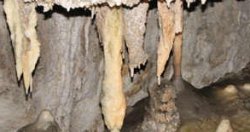
August Editorial
The role of live organisms in cave formations.

August Editorial
The role of live organisms in cave formations.
|
|
Those cave formations scientifically known as speleothems (from the Greek 'spelaion' meaning 'cave' and 'thema' meaning deposit) are secondary mineral deposits which have formed in a cave. Two of the best known of these are stalactites and stalagmites, but there are many others. These cave formations are created when acid reacts with bedrock. Possibly the most dramatic speleothems can be found in limestone-rich caves but they can also occur in granitic caves. The difference is that limestone rich caves have speleothems mainly composed of carbonate minerals, whereas in granitic caves opal-A is the main component of the speleothems. The type and the extent of speleothems and the speed at which they grow is largely determined by fluid flow, saturation, acidity and rock composition. However, still open for debate is the nature and extent of microbial involvement. Bacteria, fungi or algae are often found in caves. Therefore the question remains whether these growths are actively involved in the formation of speleothems or are simply buried within the formations as they grow. A recent study from Denmark addresses this question in detail. The researchers studied cave formations in Tjuv-Ante's Cave. Tjuv-Ante's Cave is located in northern Sweden and is a round-abraded sea cave (a 'tunnel cave') which is about 30 meters in length and was formed by rock-water abrasion. Although Tjuv-Ante's cave is officially qualified as a granite cave, it was formed within a dolerite dyke. Therefore the cave contains a large amount of dolerite (which is a coarse-grained variety of basalt). Compared to granite, the calcium content in dolerite is quite high, due to the high content of calcium-rich plagioclase and anorthite. Calcite is a common alteration mineral in mafic rocks, and therefore it is not strange that calcite is a common mineral in speleothems and other secondary precipitates of volcanic caves The mechanism of calcite speleothem formation in volcanic caves is the same as in limestone caves. Cave formations were absent from the granic part of the Tjuv-Ante's cave but a large number of speleothems were identified in the dolerite-rich areas. The authors identified two main types of cave formations: cylindrical (popcorn-like in appearance) and flowstone (thin crusts). The cylindrical formations had alternate layers of light calcite and dark silica-rich composition. The dark layer was rich in carbon and contained the remains of microorganisms. The layers indicate that the microbes were most active in spring and summer when rain dripped down through the soil above into the cave. 'These drops of water brought nutrients with them, which was consumed by the microbes. As the microbes metabolized they excreted calcium which precipitated and in time helped form the dripstones', says Magnus Ivarsson. 'Without this microbial activity dripstones would be smaller -- or maybe even totally absent', he adds. Two types of microbes were associated with the speleothems: an actinobacteria-like biofilm and a fungus. The researchers believe that actinobacteria were particularly important in the formation of speleothems. Actinobacteria were found covering large part of the speleothem surface and were identified within the darker silica-rich layers. The scientists postulate that the silica-rich layers were deposited during periods of high microbial activity during the warm humid months. The microbial biofilms were later mineralized and overgrown by calcite, thus creating the characteristic concentric stromatolite-like structures. Interestingly, the calcite layers were free from organic material. The researchers suggest that the lighter calcite layers were deposited during seasons with low or no microbial activity, whereas the actinobacteria were among the building blocks for speleothems. On the other hand, fungus was more destructive, eroding the formations by etching the calcite. Journal Reference: If you want to find out more, the full article is available online at this address: http://scholarcommons.usf.edu/cgi/viewcontent.cgi?article=1811&context=ijs |
| Home | | | Shopping | | | Database |